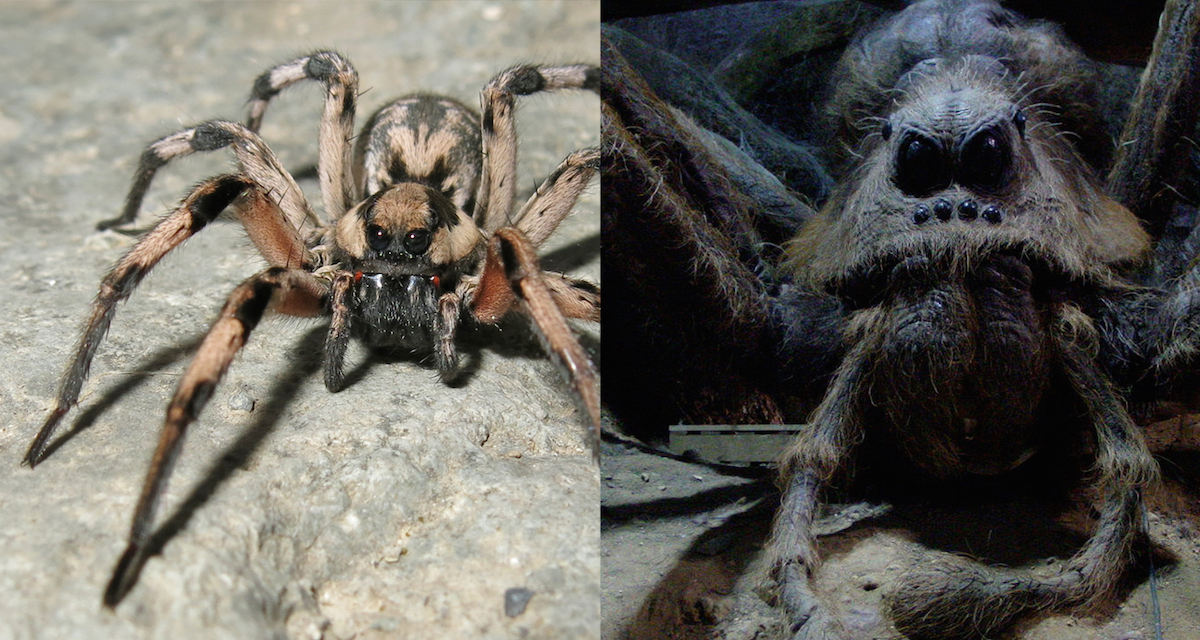When you purchase through links on our site , we may bring in an affiliate mission . Here ’s how it works .
A new identify wolf spider looks so much like Aragog , the giant , fictional spider from the " Harry Potter " series , that the creature is being named after the colossal arachnid , a newfangled study write up .
The name chance was too good to pass up , the researchers say . The animatronic tool created for the picture show " Harry Potter and the Chamber of Secrets " was based on the anatomy of a wolf spider , enjoin study cobalt - researcher Alireza Zamani , a alum bookman of animal biosystematy at the University of Tehran in Iran .

Researchers in Iran named this newly identified species of wolf spider (left) after Aragog (right), the giant spider from the “Harry Potter” series.
" We launch out that there was an extreme law of similarity between our wanderer and Aragog as he was depicted in the second moving-picture show , " Zamani tell Live Science in an email . " Since it was also the twentieth anniversary of the whole ' Harry Potter ' series , we thought it might be a safe idea and celebration of this wonderful dealership " [ to name the wanderer after Aragog ] . [ In picture : A Bevy of Magical ' Fantastic savage ' ]
Persian bugologist Alireza Naderi spotted the newfound spider near its burrow in a mountainous part of southeastern Iran ’s Kerman Province . Zamani observe that Naderi found the wanderer ( a female — the researchers have yet to discover a male ) on April 26 , 2016 , almost 19 year to the mean solar day after Aragog died ( April 20 , 1997 in the world of the Good Book ) , agree to the " Harry Potter " series , by J.K. Rowling .
investigator nominate the newfound spiderLycosa aragogi . It has a 1 - inch - long ( 2.6 centimeters ) eubstance ( exclude the leg ) , with two pitch-black and three white stripes of setae , or tomentum , on its upper body , known as the cephalothorax .

A bird’s-eye view of the newfound spider.
The arachnid also has black setae on the appendages by its sassing , " giving the spider a charismatic face , " while its abdomen is cover with black and whitened setae , said Zamani , who co - wrote the study with Anton Nadolny , a systematist who specializes in spider at the Institute of Marine Biological Research of Russian Academy of Sciences in Sevastopol , Russia .
Zamani noted that large woman chaser spiders do n’t establish web , but rather are make out as " wandering spiders " that appease in their burrows during the day and Leigh Hunt at nighttime , stalk their prey . Most live for about three geezerhood , he say .
enceinte wolf spider have good eyesight liken to most other wanderer . Four of a wolf spider ’s eight eyeshave a level of tissue screw as an iridescent tapetum behind the retinas . " After the light struggle into the eye , it chew over from the tapetum back onto the retina , making the eye glow in the darkness , similar to what we observe in some other animals , like cats , " Zamani said . " This helps arachnologists to pile up them [ the spiders ] at nighttime , using a torch [ torch ] located at our eye stage . "

A lateral view ofLycosa aragogi
gravid wolf wanderer also exhibit a great degree of maternal care : They carry their egg sac on their body and periodically expose the developing spiders to alight and heat from the Sunday for better exploitation , Zamani said . Once thespiderlings are bear , the mother maintain them on her back and feed them for the first few weeks .
This nurturing behavior is n’t so different from that of Aragog , who " loved his colony of ' Acromantulas ' [ a fictional species of wanderer ] so much he would n’t stop them from devouring Harry Potter and Ron Weasley , " Zamani state .
Even though Aragog is considered as an antagonist in the series , " I consider him as family - loving and loyal , as he would n’t harm his ex - owner Rubeus Hagrid , " Zamani said .

The study was published online July 4 in thejournal Zootaxa .
Original clause onLive skill .













